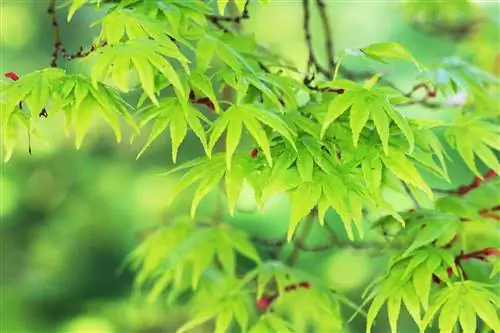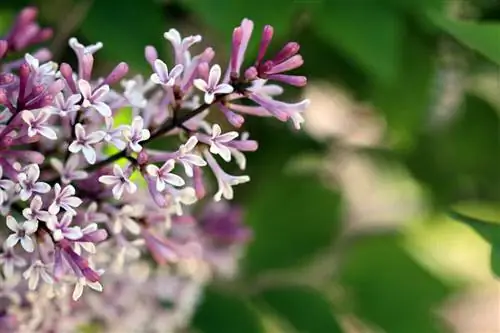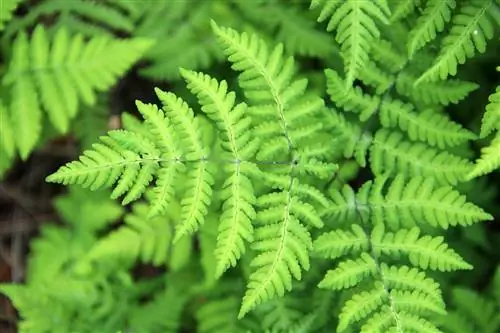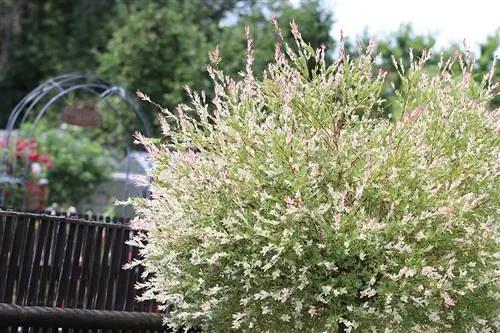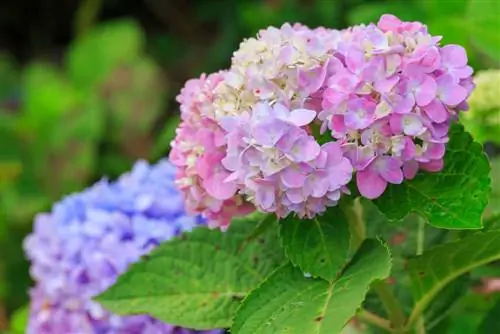- Author admin [email protected].
- Public 2023-12-17 03:39.
- Last modified 2025-01-24 12:45.
Rock pears are among the pome fruit plants. Their fruits taste aromatic and sweet and are also available in the “Juneberry” flavor.
Characteristics of the rock pear
The growth habit of the serviceberry resembles a heavily woody shrub. The copper rock pear (Amelanchier lamackii) grows between four and six meters high. The spiked rock pear (Amelanchier spicata) reaches a height of half a meter to 2.5 meters. The hanging rock pear (Amelanchier leavis) grows to three to five meters tall. The native rock pear (Amelanchier ovalis) as an original form reaches a size of between one and three meters.
In spring, from April onwards, the shrub is covered with an immense abundance of delicate white flowers. The star-shaped flowers form raceme-shaped inflorescences. The young leaves, which appear almost simultaneously, are light green and have an elongated oval shape. The first fruits form shortly after flowering. Their color ranges from dark blue to blue-black and purple. The pulp is the same color and has small seeds. The fruits are ripe in early to late July and can be eaten from the bush. All species of serviceberry produce edible fruits. The fruits, which are the size of a blueberry, are suitable as finger food or for cooking into juice and jam. If the fruits are dried, they resemble raisins. The taste of the fruits of the serviceberry is reminiscent of cherries/blueberries with marzipan. This flavor is also offered as “Juneberry” by Red Bull. The aroma is in the small seeds. Some amateur gardeners use the fruits to make liqueur. The purple sepals crown the top of the fruit.
In autumn, the rock pear surprises with its spectacular autumn color. The orange-red leaves make the rock pear an eye-catcher in the garden until it sheds its leaves. The rock pear is popularly known as the edelweiss bush or rock medlar.
Location
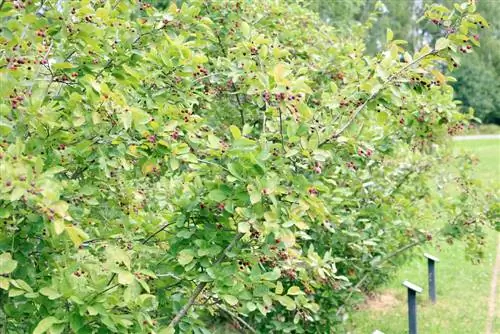
Rock pears are always underestimated. They grow on almost any soil. Drought doesn't bother them much and they thrive even in full sun or partial shade. In full shade, the rock pear does not bloom as profusely as in a sunny location. Small rock pears are suitable for the front garden or for flower pots. As a hedge, the shrub serves as a hiding place and a food source for numerous bird species. The copper rock pear is particularly suitable for the growth habit of a hedge, as the shrub grows very wide. The property's enclosure with several rock pears offers a different sight every season. However, the growth is not as opaque as other hedge plants. The rock pear is resistant to exhaust fumes and also copes well with an urban climate. Bees appreciate the many small flowers in spring as reliable pasture.
Planting and caring for rock pears
- The soil for the rock pear must be loose and water-permeable.
- Rocky ground is also a good location.
- The best planting times are in early spring and autumn.
- The planting distance should not be less than one meter.
- Annual growth of 30-60 cm per year must be expected.
- When fully grown, rock pears can reach a width of five to six meters, depending on the species.
- Young plants should be watered regularly in the first few weeks, without waterlogging.
- Older rock pears do not require any additional water or fertilizer. with lime and compost they are more likely to stimulate.
- Rock pears are hardy even at a young age.
Cut
A serviceberry doesn't actually need to be pruned. Young rock pears should not be pruned in the first few years. If the bush loses its shape, the oldest shoots can be cut out. A rejuvenation cut should be carried out in two stages. It extends over two years and is carried out in spring, on half of the branches.
If the rock pear is to develop into a tree, the lowest branches are sawn off in autumn or winter. Cutting should be started at a distance of 5 cm for thin branches and 10 cm for thick branches. This will prevent damage to the branch collar. The remaining stumps are then sawn off. This procedure is called “opcronen”. If the rock pear is allowed to grow unpruned, then after several years the rock pear will form an umbrella-like formation with slightly overhanging outer branches.
Propagation
The common serviceberry propagates by seeds or cuttings in summer. The fruits of the serviceberry are suitable for consumption, but care should be taken not to swallow any chewed seeds, as these contain small amounts of glycosides that release hydrocyanic acid. This can lead to gastrointestinal complaints, nausea and fever. However, the unchewed seeds are completely harmless because they pass through the gastrointestinal tract without being attacked. The first aid measure for chewed seeds is to drink plenty of fluids.
Diseases and pests
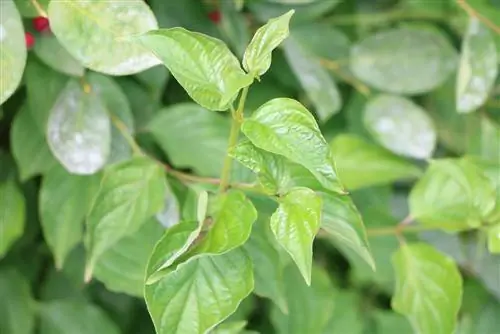
A white coating on the leaves indicates an infestation with powdery mildew. The infestation occurs from early summer to autumn. Mildew occurs particularly when warm days are followed by cool nights with dew. Powdery mildew can be controlled with a fungicide. Serviceberries can be affected by fire blight. Fire blight is caused by bacteria. In fire blight the flower styles turn black. The leaves are green-brown to black-brown in color. If leaves, flowers and fruits are dead, they remain attached to the bush. Heavily infested trees must be felled and burned. Slightly affected bushes are cut back to he althy wood up to 70 cm.
Tips for purchasing
The serviceberry is one of the oldest pome fruit bushes. Only buy a serviceberry from a nursery or nursery. If the serviceberry is to be planted as a single tree, then you have to pay attention to buying a plant that has been specially trained for this purpose. The range of young rock pears ranges from bushes to solitary plants and standard trees.
What you should know about the rock pear in brief
- A rock pear is a decorative privacy screen for the garden. It grows well in any soil and produces tasty fruits that are also good for birds. It is a species of plant from the rose family.
- Another name that is particularly common in Austria is the edelweiss shrub. Actually, that's a much more appropriate name, because when early spring is already over, the serviceberry blossoms and thousands of flowers reflect the sunlight as brilliant white.
- The German name pear comes from its appearance: the rock pear has a certain similarity to the pear, but it does not belong to the same genus as the garden pear.
- The common serviceberry is a deciduous plant that forms a richly branched and densely crowned shrub. It can reach heights of between one and four meters.
- Their branches are very slender and usually stand upright. The bark is colored black. The leaves are alternate and have the shape of an ice cream. They are either blunt or sharply serrated at the tip.
- The flowers hang in clusters of three to six in clusters or panicles, are about four millimeters wide and have a strong scent. The white flowers appear from April to June (hence the nickname Juneberry or Juneberry in English).
- The young leaves are white on the underside and later become bare. In autumn they have an orange to dark red color. The young flowers and leaves have a dense felt of white-silvery hairs. They protect the rock pear from cold and water loss.
- The leaves only reach their full size after the flowering period and only then gradually lose the hair on the underside. The flower has five completely white, widely spaced petals and five styles.
- When ripe, the small fruits are dark red to black-blue. The fruits are particularly suitable for jams or as compotes, in soups, as juice and wine and at times the tasty fruits were used as a substitute for currants in pastries.
The rock pear prefers rocky bushes, sunny and dry steep slopes, edges of semi-dry grassland and light oak and pine forests. It thrives on limestone and rock. The distribution area is in Central, Southern and Eastern Europe. Furthermore, the rock pear is also native to most of the Mediterranean region and Asia Minor. This species rises to 2,000 meters above sea level in the Southern Alps. Most species of serviceberry come from North America. In Europe, the common rock pear is at home wild on stony slopes and rocks, but is also often planted in gardens, along paths and in parks.


